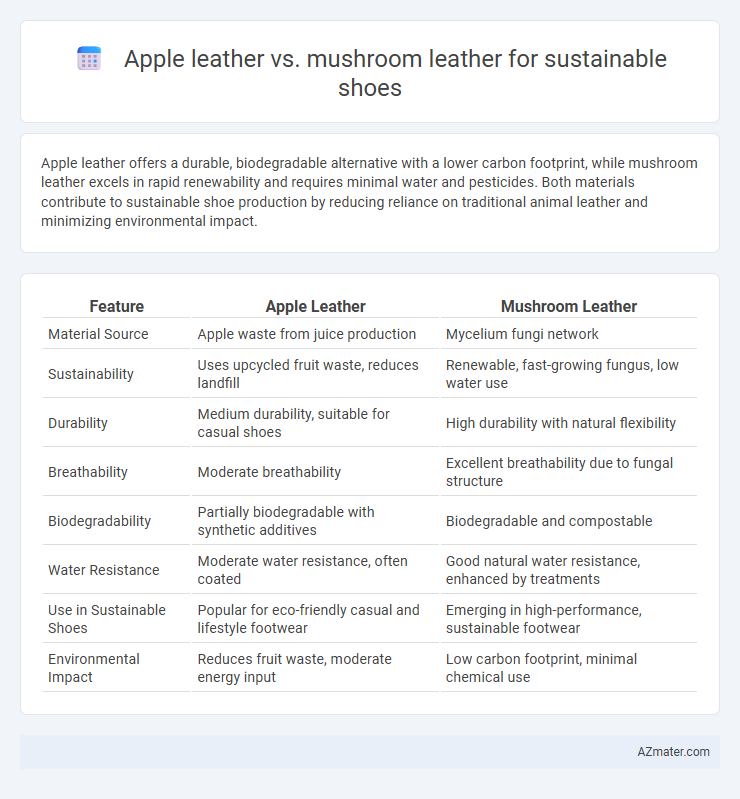Apple leather offers a durable, biodegradable alternative with a lower carbon footprint, while mushroom leather excels in rapid renewability and requires minimal water and pesticides. Both materials contribute to sustainable shoe production by reducing reliance on traditional animal leather and minimizing environmental impact.
Table of Comparison
| Feature | Apple Leather | Mushroom Leather |
|---|---|---|
| Material Source | Apple waste from juice production | Mycelium fungi network |
| Sustainability | Uses upcycled fruit waste, reduces landfill | Renewable, fast-growing fungus, low water use |
| Durability | Medium durability, suitable for casual shoes | High durability with natural flexibility |
| Breathability | Moderate breathability | Excellent breathability due to fungal structure |
| Biodegradability | Partially biodegradable with synthetic additives | Biodegradable and compostable |
| Water Resistance | Moderate water resistance, often coated | Good natural water resistance, enhanced by treatments |
| Use in Sustainable Shoes | Popular for eco-friendly casual and lifestyle footwear | Emerging in high-performance, sustainable footwear |
| Environmental Impact | Reduces fruit waste, moderate energy input | Low carbon footprint, minimal chemical use |
Introduction to Plant-Based Leathers
Plant-based leathers such as Apple leather and Mushroom leather offer eco-friendly alternatives to traditional animal hides, reducing environmental impact significantly. Apple leather is crafted from apple peels and cores, utilizing agricultural waste to create durable, biodegradable material with a low carbon footprint. Mushroom leather, derived from mycelium, features natural breathability and rapid renewability, making it a sustainable choice for innovative, environmentally conscious footwear.
What is Apple Leather?
Apple leather is a sustainable material created from apple waste pulp generated by the fruit juice industry, offering an eco-friendly alternative to traditional leather in shoe manufacturing. It features a durable, flexible texture that reduces reliance on animal hides and minimizes environmental impact through the upcycling of organic byproducts. This innovative leather alternative contributes significantly to reducing carbon emissions and water consumption associated with conventional leather production.
What is Mushroom Leather?
Mushroom leather, also known as MuSkin, is an innovative sustainable material derived from the mycelium--the root structure of mushrooms--which offers a biodegradable and eco-friendly alternative to traditional leather. This biofabricated leather requires significantly less water and energy to produce, reducing carbon emissions compared to conventional animal and synthetic leathers. Its natural texture, durability, and minimal environmental impact make mushroom leather a promising choice for sustainable footwear brands committed to reducing their ecological footprint.
Production Processes Compared
Apple leather production involves upcycling apple waste from juice production, combining apple pulp with a polyurethane binder, resulting in a durable and flexible material with lower water consumption and reduced chemical use compared to traditional leather. Mushroom leather, derived from the mycelium of fungi, undergoes a biofabrication process where mycelial networks are grown and treated to create a biodegradable, renewable, and low-impact alternative requiring minimal land and energy inputs. Both materials showcase innovative, eco-friendly production methods that significantly reduce the environmental footprint of sustainable shoe manufacturing compared to conventional animal leather.
Environmental Impact: Apple vs. Mushroom Leather
Apple leather production generates fewer greenhouse gas emissions compared to traditional leather, utilizing apple waste from juice production to reduce landfill waste and water consumption. Mushroom leather, made from mycelium, offers rapid biodegradability and lower energy requirements during cultivation, minimizing environmental pollution. Both materials significantly decrease reliance on animal leather, but mushroom leather's low resource input and compostability provide a superior ecological advantage for sustainable shoes.
Durability and Performance in Shoes
Apple leather offers moderate durability with good breathability and flexibility, making it suitable for everyday sustainable shoe use while maintaining eco-friendly credentials. Mushroom leather, derived from mycelium, provides superior water resistance and strength, often outperforming apple leather in terms of longevity and performance under varied weather conditions. Both materials reduce reliance on traditional animal leather but mushroom leather typically offers enhanced durability for high-performance or outdoor footwear.
Aesthetic and Design Flexibility
Apple leather offers a smooth, consistent texture that mimics traditional leather, providing designers with a versatile material for sleek, high-end footwear aesthetics. Mushroom leather features a unique fibrous structure that allows for breathability and organic patterns, adding natural visual interest and a rustic appeal to sustainable shoes. Both materials enable innovative design flexibility, with apple leather excelling in color uniformity and mushroom leather supporting biodegradable, eco-friendly finishes.
Cost and Market Availability
Apple leather offers moderate cost effectiveness due to its utilization of apple waste, making it relatively affordable and accessible in markets, especially in Europe. Mushroom leather, derived from mycelium, often comes at a higher price point but is gaining traction for its rapid growth cycle and biodegradability. Market availability for apple leather is more established with several brands incorporating it into sustainable shoes, whereas mushroom leather remains niche but is expanding in eco-conscious fashion sectors.
Consumer Perception and Brand Adoption
Apple leather is often perceived by consumers as a premium, eco-friendly alternative to traditional leather, favored for its natural origin and appealing texture, which enhances brand adoption among environmentally conscious buyers. Mushroom leather, derived from mycelium, is gaining rapid acceptance for its biodegradability and low environmental impact, positioning brands as innovative leaders in sustainable footwear. Both materials influence consumer perception by reinforcing values of sustainability, ethical production, and cutting-edge technology within the footwear industry.
Future Prospects in Sustainable Footwear
Apple leather and mushroom leather represent cutting-edge materials transforming the sustainable footwear industry by offering biodegradable and eco-friendly alternatives to traditional leather. Advances in mycelium technology and fruit waste upcycling enhance scalability and durability, positioning these materials as viable options for mass-market sustainable shoes. Growing consumer demand for low-impact fashion supports further innovation and investment, signaling strong future prospects for apple and mushroom leather in reducing environmental footprints in footwear production.

Infographic: Apple leather vs Mushroom leather for Sustainable shoe
 azmater.com
azmater.com